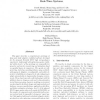339 search results - page 1 / 68 » Modeling Faults of Distributed, Reactive Systems |
FTRTFT
2000
Springer
14 years 2 months ago
2000
Springer
Formal methods can improve the development of systems with high quality requirements, since they usually o er a precise, nonambiguous speci cation language and allow rigorous veri ...
ATVA
2007
Springer
14 years 5 months ago
2007
Springer
Fault tree analysis is a traditional and well-established technique for analyzing system design and robustness. Its purpose is to identify sets of basic events, called cut sets, wh...
TPDS
2010
13 years 5 months ago
2010
In the past, some research has been done on how to use proactive recovery to build intrusion-tolerant replicated systems that are resilient to any number of faults, as long as reco...
ECBS
2005
IEEE
14 years 4 months ago
2005
IEEE
This paper describes a comprehensive prototype of large-scale fault adaptive embedded software developed for the proposed Fermilab BTeV high energy physics experiment. Lightweight...
TALG
2010
13 years 5 months ago
2010
We initiate the study of error confinement in distributed applications, where the goal is that only nodes that were directly hit by a fault may deviate from their correct external...

